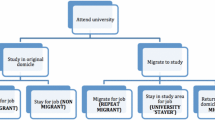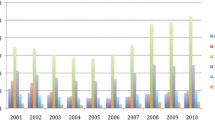Abstract
Following a recent stream of research that focuses on the migration of high-skilled workers, this paper examines the wage performance of two cohorts of Italian Ph.D. graduates associated with international mobility. After controlling for the endogeneity of the migration decision, we find that labor mobility is associated with higher wages and that selection on unobservable traits is essential to address the issue of the returns to migration. Additionally, we do not find evidence of individual heterogeneity in the response of wages to migration. We also show that our results are always confirmed when we include two exclusion restrictions in the empirical model and when we restrict the analysis to different subpopulations.

Similar content being viewed by others
Notes
Recently, Hunt (2011) has documented for the USA that skilled immigrants not only achieve success in terms of private productivity, as measured by their wage, but also in terms of creating, disseminating and commercializing knowledge.
The labor market of Ph.D.s is not restricted anymore to the education sector. This is normal in the American tradition, but quite new for European countries, where the Ph.D. has been mainly perceived as a training prerequisite for an academic career.
For instance, the EU Council Directive 2009/50/EC introduced the Blue Card, a simplified work permit allowing high-skilled non-EU citizens to work in EU countries.
The only existing study based on Italian data is the one by Ballarino and Colombo (2010). The study is based on data collected for three universities located in the North and focuses on occupational outcomes rather than the migration experience of Ph.D.s.
For a survey on program evaluation methods and advances, see Imbens and Wooldridge (2009).
The rates of holding a job for Ph.D.s who graduated in 2004 and 2006 are, respectively, 94.1 and 92.70 %.
Of the remaining unemployed Ph.D.s, 350 declared they could not find a job, 107 do not work because of personal related issues and 143 do not work for not reported reasons.
An alternative approach would be to model the migration decision in a multinomial context and correct for selectivity in a more accurate way as in Lee (1983) and Dahl (2002). Unfortunately, the number of observations for each possible destination is low given the small fraction of total movers in our data. Thus, we decided to apply a simpler model that still account for selectivity.
See Wooldridge (2010).
Gibson and McKenzie (2011), for instance, find that students who study a foreign language are more likely to move abroad.
Graduates were interviewed by a computer-assisted telephone interview (CATI).
In particular, the response rate of those who have obtained the degree in 2006 is almost 72 %, while it is slightly over 67 % for those who graduated in 2004.
Italian Ph.D. programs have a fixed duration, but allow for the possibility of an extra year to complete the thesis.
See Ciriaci (2014) for a similar approach.
All these variables are categorical and with the following categories: at least four, less than three but more than zero.
Results are omitted to ease the readability of the table, but are available upon request.
References
Abreu M, Faggian A, McCann P (2015) Migration and inter-industry mobility of UK graduates. J Econ Geogr 15(2):353–385
Angrist JD, Imbens GW, Rubin DB (1996) Identification of causal effects using instrumental variables. J Am Stat Assoc 91(434):444–455
Athey S, Katz LF, Krueger AB, Levitt S, Poterba J (2007) What does performance in graduate school predict? Graduate economics education and student outcomes. Am Econ Rev 97(2):512–518
Auriol L, Misu M, Freeman RA (2013) Careers of doctorate holders: analysis of labour market and mobility indicators. OECD Science, Technology and Industry Working Papers (4)
Ballarino G, Colombo S (2010) Occupational outcomes of PhD graduates in Northern Italy. Ital J Sociol Educ 2(2):149–171
Becker GS (1962) Investment in human capital: a theoretical analysis. J Polit Econ 70(5):9–49
Beine M, Docquier F, Rapoport H (2001) Brain drain and economic growth: theory and evidence. J Dev Econ 64(1):275–289
Beine M, Docquier F, Rapoport H (2008) Brain drain and human capital formation in developing countries: winners and losers. Econ J 118(528):631–652
Belfield C, Morris Z (1999) Regional migration to and from higher education institutions: scale, determinants and outcomes. High Educ Q 53(3):240–263
Borjas GJ (1987) Self-selection and the earnings of immigrants. Am Econ Rev 77(4):531–553
Brenzel H, Gartner H, Schnabel C (2013) Wage posting or wage bargaining? Evidence from the employers’ side. IZA Discussion Paper n7624
Calvo-Armengol A, Jackson MO (2004) The effects of social networks on employment and inequality. Am Econ Rev 94(3):426–454
Chiswick BR (1978) The effect of americanization on the earnings of foreign-born men. J Polit Econ 86(5):897–921
Ciriaci D (2014) Does university quality influence the interregional mobility of students and graduates? The case of Italy. Reg Stud 48(10):1592–1608
Corcoran J, Faggian A, McCann P (2010) Human capital in remote and rural Australia: the role of graduate migration. Growth Change 41(2):192–220
Dahl GB (2002) Mobility and the return to education: testing a roy model with multiple markets. Econometrica 70(6):2367–2420
Davis JC, Patterson DM (2000) Regional mobility of economists. J Labor Res 21(4):641–647
Détang-Dessendre C, Drapier C, Jayet H (2004) The impact of migration on wages: empirical evidence from French youth. J Reg Sci 44(4):661–691
Devillanova C (2013) Over-education and spatial flexibility: new evidence from Italian survey data. Pap Reg Sci 92(3):445–464
Di Cintio M, Grassi E (2013) Internal migration and wages of Italian university graduates. Pap Reg Sci 92(1):119–140
Docquier F, Rapoport H (2012) Globalization, brain drain, and development. J Econ Lit 50(3):681–730
Faggian A, McCann P (2009) Human capital, graduate migration and innovation in British regions. Camb J Econ 33(2):317–333
Faggian A, McCann P, Sheppard S (2007a) Some evidence that women are more mobile than men: gender differences in UK graduate migration behavior. J Reg Sci 47(3):517–539
Faggian A, McCann P, Sheppard S (2007b) Human capital, higher education and graduate migration: an analysis of Scottish and Welsh students. Urban Stud 44(13):2511–2528
Gibson J, McKenzie D (2011) The microeconomic determinants of emigration and return migration of the best and brightest: evidence from the pacific. J Dev Econ 95(1):18–29
Gottlieb P, Joseph G (2006) College-to-work migration of technology graduates and holders of doctorates within the United States. J Reg Sci 46(4):627–659
Greenwood M (1975) Research on internal migration in the United States: a survey. J Econ Lit 13(2):397–433
Groen JA (2004) The effect of college location on migration of college-educated labor. J Econ 121(1):125–142
Grogger J, Hanson GH (2013) Attracting talent: location choices of foreign-born PhDs in the US. Technical report, National Bureau of Economic Research
Grove WA, Wu S (2007) The search for economics talent: doctoral completion and research productivity. Am Econ Rev 97(2):506–511
Hall RE, Krueger AB (2010) Evidence on the determinants of the choice between wage posting and wage bargaining. Technical report, National Bureau of Economic Research
Hatton TJ (2014) The economics of international migration: a short history of the debate. Labour Econ 30:43–50
Heckman J, Vytlacil E (1998) Instrumental variables methods for the correlated random coefficient model: estimating the average rate of return to schooling when the return is correlated with schooling. J Hum Resour 33(4):974–987
Heckman JJ (1976) The common structure of statistical models of truncation, sample selection and limited dependent variables and a simple estimator for such models. In: Annals of economic and social measurement, vol 5, number 4, NBER, pp 475–492
Heckman JJ (1979) Sample selection bias as a specification error. Econometrica 47(1):153–161
Heckman JJ, LaLonde RJ, Smith J (1999) In: Ashenfelter O, Card D (eds) The economics and econometrics of active labor market programs, handbook of labor economics, vol 3A. Elsevier Science, Amsterdam, North-Holland
Heckman JJ, Urzua S, Vytlacil E (2006) Understanding instrumental variables in models with essential heterogeneity. Rev Econ Stat 88(3):389–432
Herzog HW, Hofler RA, Schlottmann AM (1985) Life on the frontier: migrant information, earnings and past mobility. Rev Econ Stat 67(3):373–382
Herzog HW Jr, Schlottmann AM, Boehm TP (1993) Migration as spatial job-search: a survey of empirical findings. Reg Stud 27(4):327–340
Hoare A, Corver M (2010) The regional geography of new young graduate labour in the UK. Reg Stud 44(4):477–494
Hunt J (2011) Which immigrants are most innovative and entrepreneurial? Distinctions by entry visa. J Labor Econ 29(3):417–457
Iammarino S, Marinelli E (2015) Education-job (mis) match and interregional migration: Italian university graduates’ transition to work. Reg Stud 49(5):866–882
Imbens GW, Wooldridge JM (2009) Recent developments in the econometrics of program evaluation. J Econ Lit 47(1):5–86
Kodrzycki YK (2001) Migration of recent college graduates: evidence from the national longitudinal survey of youth. N Engl Econ Rev 1:13–34
Lee LF (1983) Generalized econometric models with selectivity. Econometrica 51(2):507–512
Maddala GS (1986) Limited-dependent and qualitative variables in econometrics. Cambridge University Press, Cambridge
Moen ER (1997) Competitive search equilibrium. J Polit Econ 105(2):385–411
Parey M, Ruhose J, Waldinger F, Netz N (2015) The selection of high-skilled migrants. IZA Discussion Paper (9164)
Pitcher J, Purcell K (1998) Diverse expectations and access to opportunities: is there a graduate labour market? High Educ Q 52(2):179–203
Rubin DB (1974) Estimating causal effects of treatments in randomized and non-randomized studies. J Educ Psychol 66(5):688–701
Schwartz A (1976) Migration, age, and education. J Polit Econ 84(4):701–719
Shimer R (2005) The assignment of workers to jobs in an economy with coordination frictions. J Polit Econ 113(5):996–1025
Sjaastad LA (1962) The costs and returns of human migration. J Polit Econ 70(5):80–93
Stock JH, Yogo M (2005) Testing for weak instruments in linear IV regression. In: Andrews DWK, Stock JH (eds) Identification and inference for econometric models. Cambridge University Press, Cambridge, pp 80–108
Topel RH, Ward MP (1992) Job mobility and the careers of young men. Q J Econ 107(2):439–479
Venhorst V, Van Dijk J, Van Wissen L (2011) An analysis of trends in spatial mobility of Dutch graduates. Spat Econ Anal 6(1):57–82
Wooldridge JM (2010) Econometric analysis of cross section and panel data, 2nd edn. MIT press, Cambridge
Yousefi M, Rives J (1987) Migration behavior of college graduates: an empirical analysis. J Behav Econ 16(3):35–49
Acknowledgments
We acknowledge the Italian National Institute of Statistics for supplying us with the data.
Author information
Authors and Affiliations
Corresponding author
Rights and permissions
About this article
Cite this article
Di Cintio, M., Grassi, E. International mobility and wages: an analysis of Italian Ph.D. graduates. Ann Reg Sci 59, 759–791 (2017). https://doi.org/10.1007/s00168-016-0749-6
Received:
Accepted:
Published:
Issue Date:
DOI: https://doi.org/10.1007/s00168-016-0749-6




